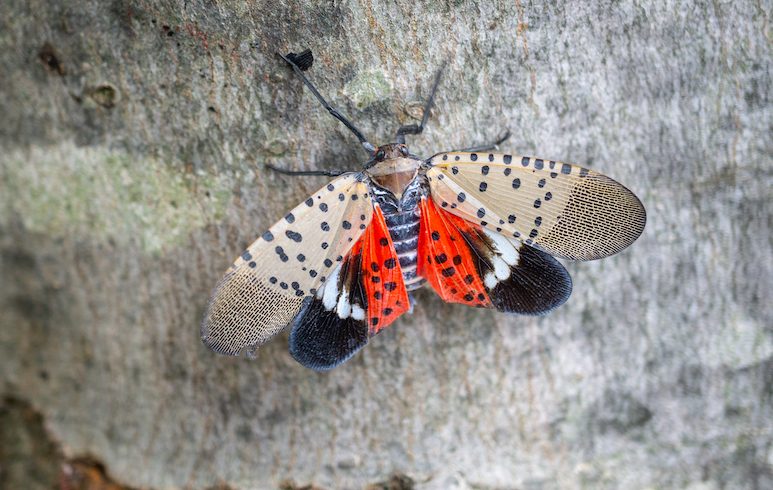
Northeastern states are attempting to stop the spread of an invasive species that threatens crops.
The Pennsylvania Department of Agriculture has an important message for anyone who comes across a spotted lanternfly: kill it, dispose of it, and report it.
The spotted lanternfly is an invasive insect species, native to parts of East and Southeast Asia. It first appeared in Berks County, Pennsylvania in 2014, and since then it has spread through most of southeastern Pennsylvania. Nearby states such as New Jersey and Virginia have also confirmed lanternfly sightings. Agencies in these states have recognized that lanternflies threaten crops and have taken steps to keep them from spreading.
The lanternfly’s diet is a cause for concern to the affected states. The lanternfly feeds primarily on sap and has a preference for the tree of heaven, itself an invasive species, which is now common across the United States. Lanternflies, however, also have an appetite for a wide variety of plants native to North America, including fruits, grains, and hardwood, and they face few natural predators. According to researchers at Penn State University, the industries most threatened by the lanternfly contribute nearly $18 billion to Pennsylvania’s economy.
Lanternflies are also able to reproduce efficiently, as they can lay eggs in almost any environment. Many insects lay eggs only on plants or soil, but lanternflies have laid eggs on cars, trains, and ships, which further enables the species to spread. The lanternfly’s appetite and breeding capabilities have led Penn State entomologist Michael Saunders to describe their population as “spectacularly exponential in its growth.”
To stop the lanternfly’s spread, the Pennsylvania Department of Agriculture issued an order in the fall of 2014 imposing requirements for travel in and out of areas where the lanternfly has been found. The Department has updated the order as the lanternfly has spread, with the current order applying to 14 counties—an area referred to as the “quarantine zone.” This zone now includes most of the Philadelphia metropolitan area. The order also declares the lanternfly to be a public nuisance, making it illegal for someone knowingly to allow it to live on their property.
The Department’s order directs individuals and businesses that have personnel and goods passing through the quarantine zone to keep from bringing lanternflies with them when they leave. For individuals, the Department provides a checklist including photos and tips for identifying lanternflies. Businesses, on the other hand, must obtain a special permit if they wish to have their employees travel into, out of, or through the quarantined area.
The business permit process is free and requires managers to complete an online training course in dealing with lanternflies. The course covers the requirements of the Department’s order, teaches best practices for limiting the lanternfly’s spread, and provides tips for identifying lanternflies and their eggs. Once these managers complete the course, they must then train their employees and implement practices such as vehicle inspections and recordkeeping of lanternfly sightings. Permits are valid for one year from the date of issuance.
The Department’s order does exempt companies that move products through the quarantined counties, with the origin and destination of the goods both lying outside the quarantine zone, as long as the goods are covered or enclosed when shipped between April and December. To qualify for the exemption, a vehicle carrying the goods must not stop within the quarantine zone, except for gas or due to traffic.
The order also establishes that “any material or object that may carry or spread” lanternflies qualifies as a “regulated article.” The list of regulated articles includes plants, construction materials, packing materials, and outdoor furnishings. An individual may not move one of these articles from the quarantine zone without completing an inspection checklist. A business needs to obtain a permit to move regulated articles.
Other states have adopted similar approaches to dealing with lanternflies. The Delaware Department of Agriculture adopted emergency regulations establishing a quarantine zone in the northern part of the state. Like Pennsylvania, Delaware requires permits for businesses that have personnel or goods traveling into or out of the quarantine zone. In addition, the list of regulated articles is almost identical to that found in Pennsylvania’s order. New Jersey and Virginia have also adopted similar quarantines for infested areas.
Although no state legislature has adopted legislation addressing the lanternfly, the presence of these insects did lead the Maryland House of Delegates to rethink planned legislation that would have banned the pesticide chlorpyrifos. Legislators there hope that the chemical might prove effective against lanternflies.
The U.S. Department of Agriculture (USDA) has announced $17.5 million in emergency funding to stop the lanternfly’s spread. In announcing this funding last year, Secretary Sonny Perdue cited the need for “decisive action.” USDA is also reportedly working with the Pennsylvania Department of Agriculture to eradicate the lanternfly throughout the region.
Despite the best efforts of state and federal agencies, the lanternfly continues to spread. Specimens have been recently discovered in Gloucester County, New Jersey—the eighth county in New Jersey to report sightings. In Pennsylvania, lanternflies have even reached the city of Philadelphia in significant numbers for the first time.
If you see a spotted lanternfly in Pennsylvania, the Pennsylvania Department of Agriculture asks you to report it by calling 1-888-4BAD-FLY or by using the Department’s online reporting tool. If you are outside of Pennsylvania, check USDA’s website for how to report.



